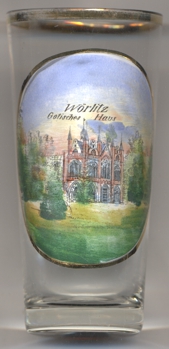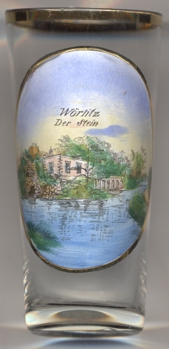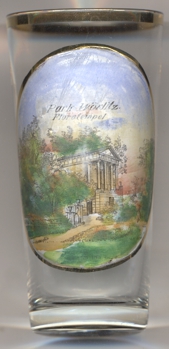

|
| DEUTSCHLAND | GERMANY |
| Bundesland: Sachsen-Anhalt | Saxony-Anhalt |
| Landkreis: Wittenberg |
Wörlitz is situated at an elevation of 62 m south of the river Elbe between Dessau-Roßlau and Wittenberg.
The oldest known written document that mentions Wörlitz dates from 1004. Already in 1440 Wörlitz was mentioned as a town. Wörlitz is best-known for Wörlitz Park, which was laid out in the second half of the 18th century during the reign of Prince Leopold III Friedrich Franz of Anhalt-Dessau. The parks cover a total area of 142 km². The historic parks of Wörlitz are included in the Dessau-Wörlitzer Gartenreich (Dessau-Wörlitz Garden Realm), listed by UNESCO as a World Cultural Heritage Sites in 2000. (see also list of other UNESCO heritage sites depicted on glasses of this collection)

The  Gothisches Haus (Gothic House) [left, no. 4067] was built in 1773–1813 in Neo-Gothic style
by the architect Friedrich Wilhelm von Erdmannsdorff. The English manor Strawberry Hill, which Prince Leopold had learnt to know during his travels, served
as a model. The front facing the Wolf canal is that of a Venetian church (Madonna del Orto in the Cannaregio sestiere), the garden
side follows the Tudor Gothic style. Both façades are focal points of visual axes, which can create the impression that there are two different buildings.
Parts of the Gothic House can be visited as a museum.
Gothisches Haus (Gothic House) [left, no. 4067] was built in 1773–1813 in Neo-Gothic style
by the architect Friedrich Wilhelm von Erdmannsdorff. The English manor Strawberry Hill, which Prince Leopold had learnt to know during his travels, served
as a model. The front facing the Wolf canal is that of a Venetian church (Madonna del Orto in the Cannaregio sestiere), the garden
side follows the Tudor Gothic style. Both façades are focal points of visual axes, which can create the impression that there are two different buildings.
Parts of the Gothic House can be visited as a museum.

 Der Stein (The Stone) [near left, no. 4068] is an artificial island, which was created in
1788–1794 according to plans by Prince Leopold III Friedrich Franz as a reminder of his stay in the Gulf of Naples. It houses rock passages,
grottos, the temple of the day, the temple of night, a columbarium, an amphitheater, the Villa Hamilton and is crowned by an artificial volcano that is
modeled on mount Vesuvius. As a highlight, the “Vesuvius of Wörlitz” [background] was able to “spit lava” at the prince's garden
festivals using sophisticated sound, light and water effects. At the end of August 2005 and 2006, the volcanic eruption was demonstrated again for the first
time. Due to severe structural damage, the island had to be closed to visitors for a long time and, after extensive restoration, has been open to the public
again since September 2005. The old gondola berth in the caves can no longer be used after the renovation work. The Villa Hamilton (depicted on glass
no. 4068) was dedicated by the prince to the archaeologist, volcanologist and English ambassador at the court of the King of Naples, Sir William
Hamilton), who was the host of the prince and his builder on the trip to the Gulf of Naples. The Casino di Mappinola on the Posilippo coast (called Villa
Emma) used by Hamilton served as a model for the villa, which consists of three rooms.
Der Stein (The Stone) [near left, no. 4068] is an artificial island, which was created in
1788–1794 according to plans by Prince Leopold III Friedrich Franz as a reminder of his stay in the Gulf of Naples. It houses rock passages,
grottos, the temple of the day, the temple of night, a columbarium, an amphitheater, the Villa Hamilton and is crowned by an artificial volcano that is
modeled on mount Vesuvius. As a highlight, the “Vesuvius of Wörlitz” [background] was able to “spit lava” at the prince's garden
festivals using sophisticated sound, light and water effects. At the end of August 2005 and 2006, the volcanic eruption was demonstrated again for the first
time. Due to severe structural damage, the island had to be closed to visitors for a long time and, after extensive restoration, has been open to the public
again since September 2005. The old gondola berth in the caves can no longer be used after the renovation work. The Villa Hamilton (depicted on glass
no. 4068) was dedicated by the prince to the archaeologist, volcanologist and English ambassador at the court of the King of Naples, Sir William
Hamilton), who was the host of the prince and his builder on the trip to the Gulf of Naples. The Casino di Mappinola on the Posilippo coast (called Villa
Emma) used by Hamilton served as a model for the villa, which consists of three rooms.

The  Floratempel (Flora Temple) [near left, no. 4069] was created in 1797–1798 by the architect
Friedrich Wilhelm von Erdmannsdorff. The model for this building was the temple of Clitumnus in Spoleto, Italy. The building was used as a music pavillon.
Floratempel (Flora Temple) [near left, no. 4069] was created in 1797–1798 by the architect
Friedrich Wilhelm von Erdmannsdorff. The model for this building was the temple of Clitumnus in Spoleto, Italy. The building was used as a music pavillon.
[https://de.wikipedia.org/wiki/W%C3%B6rlitz;
https://de.wikipedia.org/wiki/Dessau-W%C3%B6rlitzer_Gartenreich;
https://de.wikipedia.org/wiki/Friedrich_Wilhelm_von_Erdmannsdorff;
https://artsandculture.google.com/asset/w%C3%B6rlitz-temple-of-flora-friedrich-wilhelm-von-erdmannsdorff/ogEwOKoPs4_kPQ?hl=de]
![[scale]](lineal.jpg)